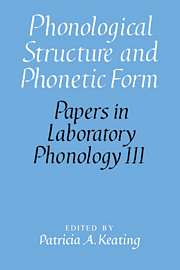Book contents
- Frontmatter
- Contents
- List of contributors
- Acknowledgments
- 1 Introduction
- I Intonation
- II Syllables
- 8 Articulatory phonetic clues to syllable affiliation: gestural characteristics of bilabial stops
- 9 The phonology and phonetics of extrasyllabicity in French
- 10 Phonetic correlates of syllable affiliation
- 11 Syllable structure and word structure: a study of triconsonantal clusters in English
- III Feature Theory
- IV Phonetic Output
- Index of subjects
- Index of names
11 - Syllable structure and word structure: a study of triconsonantal clusters in English
Published online by Cambridge University Press: 26 February 2010
- Frontmatter
- Contents
- List of contributors
- Acknowledgments
- 1 Introduction
- I Intonation
- II Syllables
- 8 Articulatory phonetic clues to syllable affiliation: gestural characteristics of bilabial stops
- 9 The phonology and phonetics of extrasyllabicity in French
- 10 Phonetic correlates of syllable affiliation
- 11 Syllable structure and word structure: a study of triconsonantal clusters in English
- III Feature Theory
- IV Phonetic Output
- Index of subjects
- Index of names
Summary
Introduction
Current phonological theory maximizes the responsibility of the syllable for explaining co-occurrence restrictions on consonants. The inventory of wordinitial consonant clusters is chiefly explained by the constraints on the syllable onset. The syllable coda also plays a central role in explaining which word-final consonants are permissible. The word node comes into play only by picking up extra peripheral elements, most notably the coronal appendices of English, and by defining the domain for any co-occurrence restrictions which cross syllable boundaries. (See Fudge 1969; Fujimura and Lovins 1978; Selkirk 1982; Clements and Keyser 1983.) With the phonotactic responsibility of the syllable thus maximized, the crossproduct of codas and onsets is the starting point for any description of medial clusters. That is, in the absence of additional provisos, any concatenation of a well-formed coda and a well-formed onset is predicted to be possible medially in a word.
The present project evaluated the extent to which syllable structure explains the inventory of long medial clusters – the clusters of three or more consonants – in English. It was motivated by the observation that wordinternally such clusters are extremely restricted in comparison with the set defined by the cross-product of codas and onsets. The basic model obviously requires modification, and a detailed examination of the occurring and missing clusters reveals what type of modification is needed.
Two methods were applied in the study. The pronunciation fields of the on-line Collins English Dictionary (distributed through the ACL Data Collection Initiative) were used to make an inventory of onsets, codas, and their frequencies, and to establish which medial clusters occur at all.
- Type
- Chapter
- Information
- Phonological Structure and Phonetic Form , pp. 168 - 188Publisher: Cambridge University PressPrint publication year: 1994
- 50
- Cited by



